
(a)
Interpretation:
Amino acid from Table 23.1 should be classified into each of the categories nonpolar v. polar.
Concept introduction:
Proteins are
They polymerize by peptide linkage to form dipeptide, oligopeptide and polypeptide molecules. Each peptide bond formation is a condensation reaction that occurs with the elimination of water molecule.
Answer to Problem 6SSC
Glycine, valine and phenylalanine are nonpolar amino acids and, serine, cysteine, lysine, glutamic acid, glutamine are polar amino acids.
Explanation of Solution
Polar amino acid is directed towards the outside of the protein because of the hydrophilic properties of side chain whereas the nonpolar amino acid is directed towards the inside of protein (R group repelled by water) because of the hydrophobic nature.
The given amino acids are: Glycine, Serine, Cysteine, Lysine, Glutamic acid, Glutamine, Valine and Phenylalanine.
The structure of Glutamine is:
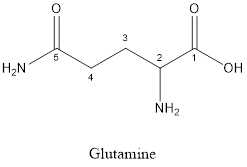
The structure of serine is:
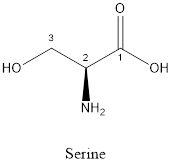
The structure of Cysteine is:
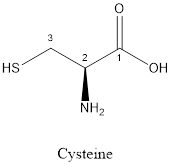
The structure of Lysine:
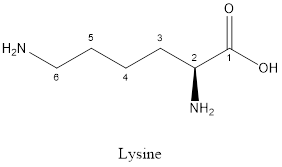
The structure of glutamic acid:
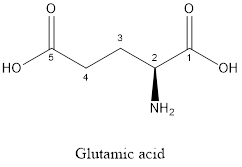
The structure of Glycine is:
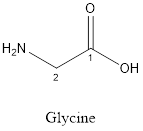
The structure of valine is:
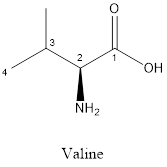
The structure of phenylalanine is:
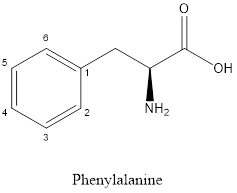
Glycine is nonpolar as it is neutral species; also nonpolar hydrogen is linked as shown below:
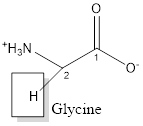
Valine is nonpolar as it is neutral species; also nonpolar group is linked as shown below:
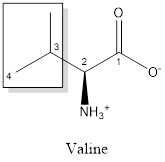
Serine is polar amino acid as it consists of polar R group:
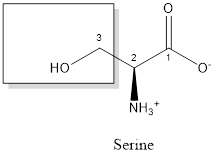
Cysteine is polar amino acid as it consists of polar R group:

Glutamine is a polar amino acid as it consists of polar R group:
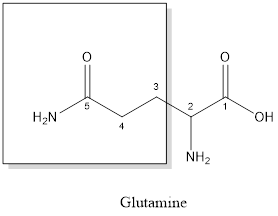
Lysine is a polar amino acid as it consists of polar R group:
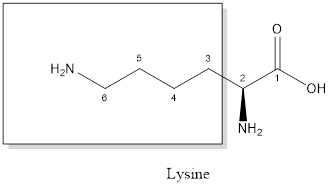
Glutamic acid is a polar amino acid as it consists of polar R group:
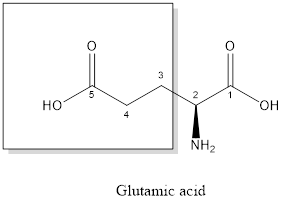
Phenylalanine is nonpolar as it is neutral species; also nonpolar group is linked as shown below:
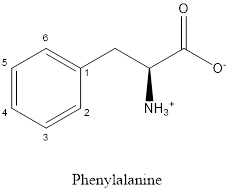
Therefore; glycine, valine and phenylalanine are nonpolar amino acids and, serine, cysteine, lysine, glutamic acid, glutamine are polar amino acids.
(b)
Interpretation:
Amino acid from Table 23.1 should be classified into each of the categories aromatic v. aliphatic.
Concept introduction:
Proteins are polymeric biomolecules which are formed by the polymerisation of amino acids. Amino acids are the organic molecules with
They polymerize by peptide linkage to form dipeptide, oligopeptide and polypeptide molecules. Each peptide bond formation is a condensation reaction that occurs with the elimination of water molecule.
Answer to Problem 6SSC
The amino acids which are aliphatic in nature are glycine, serine, cysteine, lysine, glutamic acid, glutamine, valine whereas the amino acid which is aromatic.
Explanation of Solution
A cyclic ring structure which contains carbon atoms and hydrogen atoms is known as aromatic ring and the compound which has aromatic ring is known as
The compound which consists of carbon and hydrogen linked with each other either in a straight chain, branched chain and non-aromatic rings is known as aliphatic compounds.
The given amino acids are: Glycine, Serine, Cysteine, Lysine, Glutamic acid, Glutamine, Valine and Phenylalanine.
The structure of Glutamine is:
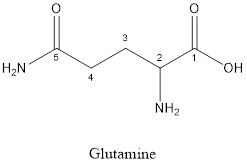
The structure of serine is:

The structure of Cysteine is:
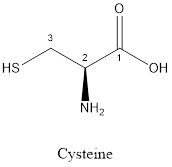
The structure of Lysine:

The structure of glutamic acid:
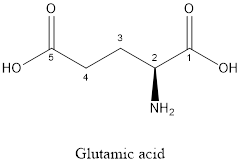
The structure of Glycine is:
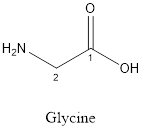
The structure of valine is:
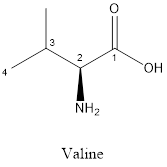
The structure of phenylalanine is:
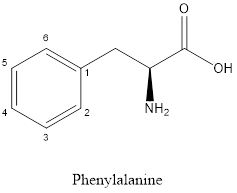
According to above structures, the amino acids which are aliphatic in nature are glycine, serine, cysteine, lysine, glutamic acid, glutamine, valine as these amino acids contain carbon and hydrogen bonds (hydrocarbon) whereas the amino acid which is aromatic is phenylalanine as it contains aromatic ring in its side chain.
(c)
Interpretation:
Amino acid from Table 23.1 should be classified into each of the categories acidic v. basic.
Concept introduction:
Proteins are polymeric biomolecules which are formed by the polymerisation of amino acids. Amino acids are the organic molecules with
They polymerize by peptide linkage to form dipeptide, oligopeptide and polypeptide molecules. Each peptide bond formation is a condensation reaction that occurs with the elimination of water molecule.
Answer to Problem 6SSC
Lysine and Glutamic acid is basic and acidic amino acid. The remaining amino acids are neutral.
Explanation of Solution
The amino acids which contain R group as a
The amino acids which contain R group as a
The given amino acids are: Glycine, Serine, Cysteine, Lysine, Glutamic acid, Glutamine, Valine and Phenylalanine.
The structure of Glutamine is:
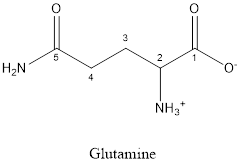
Glutamine is neither acidic nor basic as the side chain of glutamine is uncharged (polar R group). Thus, glutamine is a neutral amino acid.
The structure of serine is:
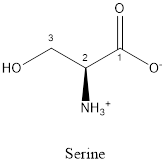
Serine is neither acidic nor basic as the side chain of serine is uncharged (polar R group). Thus, serine is a neutral amino acid.
The structure of Cysteine is:
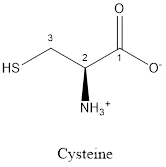
Cysteine is neither acidic nor basic as the side chain of cysteine is uncharged (polar R group). Thus, cysteine is a neutral amino acid.
The structure of Lysine:
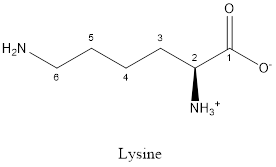
Lysine is basic in nature as the side chain of lysine consists of amine group. Thus, lysine is a basic amino acid.
The structure of glutamic acid:
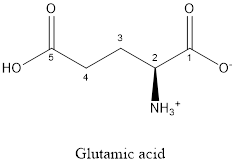
Glutamic acid is acidic in nature as the side chain of glutamic acid consists of carboxylic group. Thus, Glutamic acid is an acidic amino acid.
The structure of Glycine is:
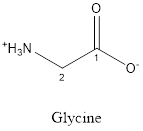
Glycine is neither acidic nor basic as the side chain of glycine is uncharged (polar R group). Thus, glycine is a neutral amino acid.
The structure of valine is:
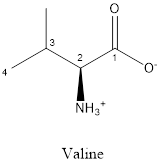
Valine is neither acidic nor basic as the side chain of valine is uncharged (polar R group). Thus, valine is a neutral amino acid.
The structure of phenylalanine is:
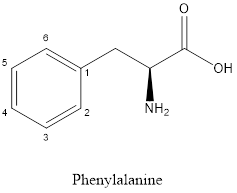
Phenylalanine is neither acidic nor basic as the side chain of phenylalanine is uncharged (polar R group). Thus, phenylalanine is a neutral amino acid.
Chapter 23 Solutions
Chemistry: Matter and Change
Additional Science Textbook Solutions
Organic Chemistry (8th Edition)
Genetic Analysis: An Integrated Approach (3rd Edition)
Chemistry: Structure and Properties (2nd Edition)
Applications and Investigations in Earth Science (9th Edition)
Campbell Essential Biology (7th Edition)
Biology: Life on Earth (11th Edition)
- (2 pts) Why is O2 more stable as a diatomic molecule than S2?arrow_forwardDraw the Lewis structure for the polyatomic phosphite (PO¾³¯) a anion. Be sure to include all resonance structures that satisfy the octet rule. C I A [ ]¯arrow_forwardDecide whether these proposed Lewis structures are reasonable. proposed Lewis structure Is the proposed Lewis structure reasonable? Yes. :0: Cl C C1: 0=0: : 0 : : 0 : H C N No, it has the wrong number of valence electrons. The correct number is: ☐ No, it has the right number of valence electrons but doesn't satisfy the octet rule. The symbols of the problem atoms are:* ☐ Yes. No, it has the wrong number of valence electrons. The correct number is: ☐ No, it has the right number of valence electrons but doesn't satisfy the octet rule. The symbols of the problem atoms are:* Yes. ☐ No, it has the wrong number of valence electrons. The correct number is: ☐ No, it has the right number of valence electrons but doesn't satisfy the octet rule. The symbols of the problem atoms are:* | * If two or more atoms of the same element don't satisfy the octet rule, just enter the chemical symbol as many times as necessary. For example, if two oxygen atoms don't satisfy the octet rule, enter "0,0".arrow_forward
- Draw the Lewis structure for the polyatomic trisulfide anion. Be sure to include all resonance structures that satisfy the octet rule. с [ ] - Garrow_forward1. Calculate the accurate monoisotopic mass (using all 1H, 12C, 14N, 160 and 35CI) for your product using the table in your lab manual. Don't include the Cl, since you should only have [M+H]*. Compare this to the value you see on the LC-MS printout. How much different are they? 2. There are four isotopic peaks for the [M+H]* ion at m/z 240, 241, 242 and 243. For one point of extra credit, explain what each of these is and why they are present. 3. There is a fragment ion at m/z 184. For one point of extra credit, identify this fragment and confirm by calculating the accurate monoisotopic mass. 4. The UV spectrum is also at the bottom of your printout. For one point of extra credit, look up the UV spectrum of bupropion on Google Images and compare to your spectrum. Do they match? Cite your source. 5. For most of you, there will be a second chromatographic peak whose m/z is 74 (to a round number). For one point of extra credit, see if you can identify this molecule as well and confirm by…arrow_forwardPlease draw, not just describe!arrow_forward
- can you draw each step on a piece of a paper please this is very confusing to mearrow_forward> Can the molecule on the right-hand side of this organic reaction be made in good yield from no more than two reactants, in one step, by moderately heating the reactants? esc ? A O O •If your answer is yes, then draw the reactant or reactants in the drawing area below. You can draw the reactants in any arrangement you like. • If your answer is no, check the box under the drawing area instead. olo 18 Ar Explanation Check BB Click and drag to start drawing a structure. 2025 McGraw Hill LLC. All Rights Reserved. Terms of Use | Privacy Center Accessibilityarrow_forwardName the structurearrow_forward
- > For each pair of substrates below, choose the one that will react faster in a substitution reaction, assuming that: 1. the rate of substitution doesn't depend on nucleophile concentration and 2. the products are a roughly 50/50 mixture of enantiomers. Substrate A Substrate B Faster Rate X CI (Choose one) (Choose one) CI Br Explanation Check Br (Choose one) C 2025 McGraw Hill LLC. All Rights Reserved. Terms of Use | Privacy A F10arrow_forwardHow to draw this mechanism for the foloowing reaction in the foto. thank youarrow_forwardPredict the major products of the following organic reaction: Some important notes: CN A? • Draw the major product, or products, of the reaction in the drawing area below. • If there aren't any products, because no reaction will take place, check the box below the drawing area instead. • Be sure to use wedge and dash bonds when necessary, for example to distinguish between major products that are enantiomers. No reaction. Explanation Check Click and drag to start drawing a structure. 2025 McGraw Hill LLC. All Rights Reserved. Terms of Use Privacy Centerarrow_forward
 ChemistryChemistryISBN:9781305957404Author:Steven S. Zumdahl, Susan A. Zumdahl, Donald J. DeCostePublisher:Cengage Learning
ChemistryChemistryISBN:9781305957404Author:Steven S. Zumdahl, Susan A. Zumdahl, Donald J. DeCostePublisher:Cengage Learning ChemistryChemistryISBN:9781259911156Author:Raymond Chang Dr., Jason Overby ProfessorPublisher:McGraw-Hill Education
ChemistryChemistryISBN:9781259911156Author:Raymond Chang Dr., Jason Overby ProfessorPublisher:McGraw-Hill Education Principles of Instrumental AnalysisChemistryISBN:9781305577213Author:Douglas A. Skoog, F. James Holler, Stanley R. CrouchPublisher:Cengage Learning
Principles of Instrumental AnalysisChemistryISBN:9781305577213Author:Douglas A. Skoog, F. James Holler, Stanley R. CrouchPublisher:Cengage Learning Organic ChemistryChemistryISBN:9780078021558Author:Janice Gorzynski Smith Dr.Publisher:McGraw-Hill Education
Organic ChemistryChemistryISBN:9780078021558Author:Janice Gorzynski Smith Dr.Publisher:McGraw-Hill Education Chemistry: Principles and ReactionsChemistryISBN:9781305079373Author:William L. Masterton, Cecile N. HurleyPublisher:Cengage Learning
Chemistry: Principles and ReactionsChemistryISBN:9781305079373Author:William L. Masterton, Cecile N. HurleyPublisher:Cengage Learning Elementary Principles of Chemical Processes, Bind...ChemistryISBN:9781118431221Author:Richard M. Felder, Ronald W. Rousseau, Lisa G. BullardPublisher:WILEY
Elementary Principles of Chemical Processes, Bind...ChemistryISBN:9781118431221Author:Richard M. Felder, Ronald W. Rousseau, Lisa G. BullardPublisher:WILEY





